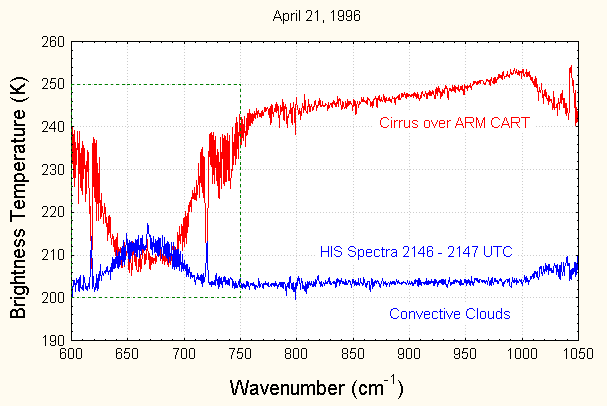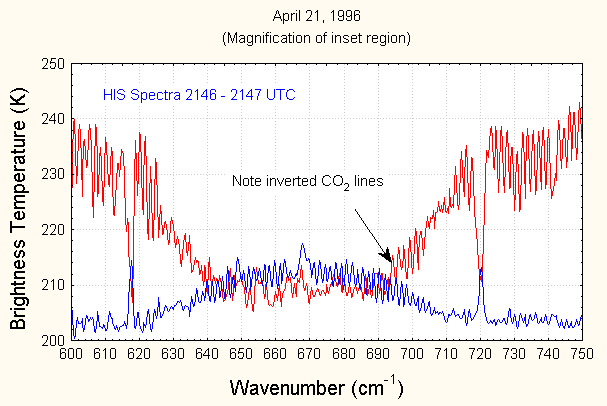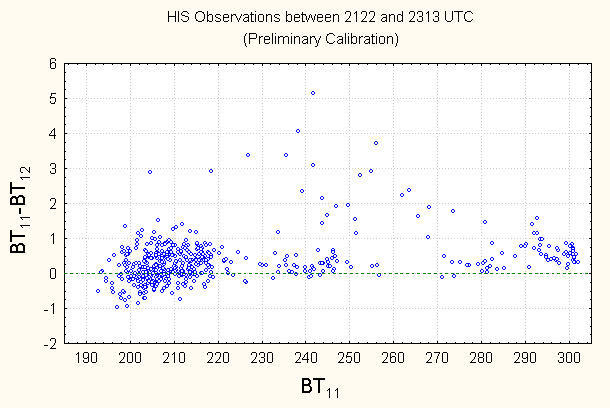
Observations of negative difference of 11 micron minus 12 micron brightness temperature (T11-T12) over cold clouds have been previously found in radiometric data from several remote sensing platforms (Ackerman et al., 1994, Moeller et al 1996). These observations run counter to bulk absorption properties of ice (and water) cloud particles. At issue is the physical explanation of these observations. Absolute calibration error has been suggested as a possible explanation. However, the multi-sensor occurrence of negative differences reduces the likelihood of calibration error.
Negative differences were found in MODIS Airborne Simulator (MAS, on NASA ER-2 aircraft) (King et al., 1995), AVHRR (NOAA-12), VISSR Atmospheric Sounder (VAS, on GOES-7), HIRS/2 (NOAA-12), and GOES-8 imager data sets; however these negative differences were not well corroborated by a well-calibrated radiometer (Ackerman et al 1994, Moeller et al 1996.)
Absolute calibration error has been raised as a possible explanation for negative differences and is addressed by Moeller et al (1996). Previously, no negative differences were found when well-calibrated (< 1 K) High resolution Interferometer Sounder (HIS, on NASA ER-2 aircraft) (Smith, et al., 1993) data was used to simulate MAS, AVHRR and VAS radiances; however insufficient collocated cold cloud scene data were available for direct comparison between HIS and MAS, AVHRR, or VAS. In addition, it did not appear that the HIS had overflown the correct cloud conditions which have the negative signature.
GOES-8 visible imagery on 21 April 1996 shows a convective line in the vicinity of the ARM CART site. This line of convection was overflown by the ER-2 in an attempt to verify the occurance of negative differences using the HIS observations. A time series plot of the HIS observed brightness temperature near 11 microns for a time period when the ER-2 was over the convective line is shown below. The temperature of the overshooting tops is less than 200K. The MIR (Wang et al, 1995) observed covective overshooting tops between 2145 and 2150 UTC as noted on the figure. These active convective cells have shown negative BT11-BT12 differences.

The following figure shows an average of 10 HIS spectra over a cold scene for 600 to 1050 cm-1 (blue line). The CO2 and ozone bands are warmer than the atmosperic window because of the temperature inversion in the stratosphere. The red line represents specture observed earlier in the day while the ER-2 was overflying cirrus at the ARM CART site. A magnification of the green box is shown below.


The figure below plots BT11-BT12 versus BT11 using observations of the HIS. Negative differences of 0 to -1 K where observed for cold scenes associated with vigorous cell growth of the convective line. Unfortunately the second data recorder of the MAS failed prior to this time period (see ER-2 summary page.) While preliminary in nature, these HIS observed negative differences lend support to the argument that the differences are real. The nature of these observations has not been identified although some patterns to these observations are beginning to emerge (see Moeller et al, 1996 for more detail.) An in-depth analysis of the HIS in conjuction with observations for the MIR and GOES-8 is planned.

Ackerman, S. A., C. C. Moeller, K. I. Strabala, W. P. Menzel, W. L. Smith, 1994: Negative 11 micron minus 12 micron brightness temperature differences: instrument calibration or reality. Poster presented at 7th Conference on Satellite Meteorology and Oceanography, June 6-10, 1994 Monterey, CA, Amer. Meteor. Soc. Conference paper available from authors.
Moeller, C. C., S. A. Ackerman, K. I. Strabala, W. P. Menzel, W. L. Smith, 1994: Negative 11 micron minus 12 micron brightness temperature differences: A second look. Poster presented at 8th Conference on Satellite Meteorology and Oceanography, Feb 1996 Amer. Meteor. Soc. Conference paper available from authors.
King, M. D., W. P. Menzel, P. S. Grant, J. S. Myers, G. T. Arnold, S. Platnick, L. E. Gumley, S. Tsay, C. C. Moeller, M. Fitzgerald, K. S. Brown, and F. Osterwisch, 1996: Airborne scanning spectrometer for remote sensing of cloud, aerosol, water vapor and surface properties. In press Jour. Atmos. and Oceanic Tech.
Wang, J. R, S. H. Melfi, P. Racette, D. N. Whitemen, L. A. Chang, R. A. Ferrare, K. D. Evans, and F. J. Schmidlin, 1995: Simultaneous measurements of atmospheric water vapor with MIR, Raman lidar, and rawindondes, J. Appl. Meteor., 34, 1595_1607.
Smith, W. L., H. E. Revercomb, H.-L. Huang, and R. O. Knuteson, 1993: Vertical sounding capabilities with high spectral resolution atmospheric radiation measurements - a demonstration with the High resolution Interferometer Sounder (HIS). High Spectral Resolution Infrared Remote Sensing for Earth's Weather and Climate Studies. Edited by A. Chedin, M. T. Chahine and N. A. Scott. Spinger-Verlag, Berlin. 131-146.